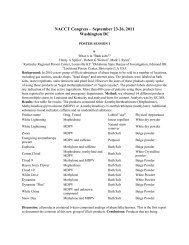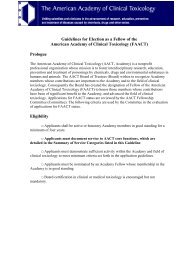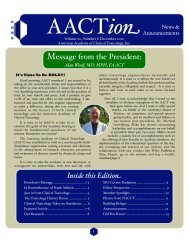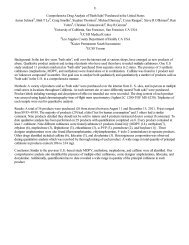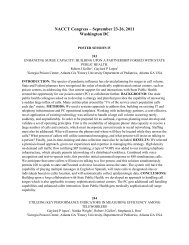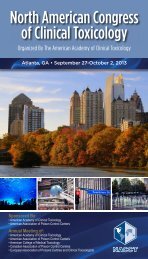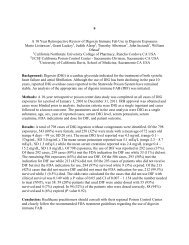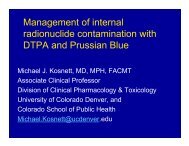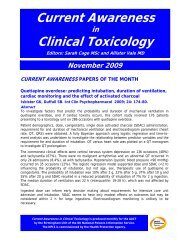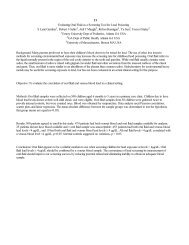Position Paper: Single-Dose Activated Charcoal - eapcct
Position Paper: Single-Dose Activated Charcoal - eapcct
Position Paper: Single-Dose Activated Charcoal - eapcct
Create successful ePaper yourself
Turn your PDF publications into a flip-book with our unique Google optimized e-Paper software.
64<br />
POSITION PAPER: SINGLE-DOSE ACTIVATED CHARCOAL<br />
Heogberg et al. (24) investigated the in vitro adsorptive<br />
affinity of two different activated charcoal products for paracetamol.<br />
and the affect of ethanol on the adsorptive properties<br />
of activated charcoal. Paracetamol was incubated with<br />
activated charcoal in activated charcoal:paracetamol ratios of<br />
1:1, 2:1, 3:1, 5:1, 10:1 in simulated gastric and intestinal<br />
environments of pH 1.2 and 7.2, respectively. The Langmuir<br />
adsorption isotherms were used to determine the adsorption of<br />
paracetamol to activated charcoal. The Langmuir plots<br />
demonstrated the high affinity of both charcoals for paracetamol<br />
at pH 1.2 and 7.2.<br />
Impact of Ethanol on Drug Adsorption to <strong>Charcoal</strong><br />
Heogberg et al. (24) investigated the effect of ethanol on<br />
the adsorptive properties of activated charcoal. Ethanol 10%<br />
v/v was incubated with activated charcoal 250 mg and with the<br />
activated charcoal and paracetamol mixtures(activated charcoal:<br />
paracetamol ratios of 1:1, 2:1, 3:1, 5:1, 10:1). Ethanol<br />
was not adsorbed by activated charcoal significantly. However,<br />
ethanol caused a statistically significant reduction in the<br />
maximal adsorptive capacity of charcoal of 11.0–11.3% with<br />
Norit Supra A and a 20.4–25.3% reduction with Carbomix.<br />
The authors concluded that ethanol changed the polarity of<br />
paracetamol and decreased its binding to charcoal and that<br />
Norit Supra may be clinically superior to Carbomix in highdose<br />
intoxications.<br />
Animal Studies<br />
Several approaches have been used to demonstrate an<br />
attenuation of pharmacological or toxicological effects, poison<br />
concentration, or systemic absorption in animals treated with<br />
activated charcoal (1). Typically these studies have used a<br />
control group receiving no activated charcoal. The application<br />
of these animal findings to humans involves problems with<br />
interspecies scaling such as differences in gastrointestinal<br />
motility and morphology, absorption rate and site, dose of<br />
poison and dosage form, and metabolism and elimination rates<br />
and pathways. Nevertheless, animal studies serve to confirm in<br />
vitro adsorption studies by demonstrating in vivo reduction in<br />
a poison’s effect or absorption. Many animal studies reported<br />
statistical analysis of the data comparisons; others reported<br />
data compared with a control group deemed to be sufficiently<br />
different to demonstrate a change. Direct extrapolation of the<br />
findings in animal studies to human poisoning should be done<br />
cautiously, if at all, and accordingly, few studies are reviewed<br />
in this document.<br />
Volunteer Studies<br />
Studies in human volunteers are based typically on the<br />
comparative bioavailability studies of a test drug using a controlled,<br />
randomized, crossover design involving six to ten<br />
participants. Measures such as the area-under-the-curve (AUC)<br />
of drug concentration versus time or the extent of recovery of<br />
the drug in urine are employed depending upon the properties<br />
of the drug. Since human volunteers are used as experimental<br />
subjects, only subtoxic doses of drugs have been studied.<br />
Some studies have attempted to correlate in vitro adsorption<br />
to reduction in absorption (20,21,25,26). Although these studies<br />
serve to confirm basic principles of adsorption, the results<br />
cannot be extrapolated directly to the care of a poisoned patient.<br />
Extrapolation of data from human volunteer studies to<br />
patients who overdose is difficult because of the following<br />
factors: 1) variations in pharmacokinetics (e.g. differing<br />
dissolution, gastric emptying, and absorption rates) seen with<br />
toxic as opposed to therapeutic doses (27); 2) variable delay in<br />
the administration of activated charcoal; and 3) differences in<br />
the adsorptive properties of activated charcoal present in the<br />
stomach of a fasting human volunteer compared with the<br />
varying stomach contents of some patients who overdose.<br />
The results of 122 comparisons involving 46 drugs are<br />
tabulated in Appendix 1. There is considerable variation in the<br />
absolute amount of charcoal used (0.5–100 g) and the<br />
resulting gram-to-gram ratio of charcoal to drug (1:1 to<br />
100,000:1). The time delay for the administration of the<br />
charcoal was up to 360 minutes after drug administration.<br />
Eighty-four comparisons took place at 45 minutes<br />
(Table 2). In these studies when activated charcoal was<br />
administered at 30 minutes, there was a mean reduction in<br />
absorption of 51.70% (n=7); at 60 minutes the mean reduction<br />
was 38.14% (n=16); at 120 minutes the mean reduction was<br />
34.54% (n=8). The data from 48 comparisons involving 26<br />
drugs using at least 50 g of activated charcoal (Table 3)<br />
showed a mean reduction in absorption of 47.3% (n=3) when<br />
activated charcoal was administered at 30 minutes after dosing;<br />
the mean reduction at 60 minutes was 40.07% (n=12), and at<br />
120 minutes was 16.50% (n=3). These volunteer studies<br />
demonstrate that the maximum reduction in drug absorption<br />
occurs when activated charcoal is administered within 60<br />
minutes of drug dosing.<br />
Data from studies where activated charcoal was administered<br />
at or more that 120 minutes after dosing are given in<br />
detail below.<br />
Impact of <strong>Activated</strong> <strong>Charcoal</strong> Administered 120<br />
Minutes After Dosing<br />
Yeates and Thomas (28) conducted an open, randomized,<br />
crossover four-arm study in volunteers to determine the<br />
efficacy of activated charcoal in reducing paracetamol<br />
absorption when the administration of charcoal was delayed<br />
by 1, 2, or 4 hours. Volunteers consumed a standard breakfast<br />
followed one hour later by paracetamol 3 g and no charcoal or<br />
charcoal 50 g delayed by 1–4 hours. Blood samples were<br />
obtained over a 9 hour period and statistical comparisons were<br />
made between the area under the serum concentration-time<br />
curves (AUC mcg/L-hours) values. AUCs between 4 and<br />
9 hours showed statistically significant reductions at 1 hour<br />
(56%; p



